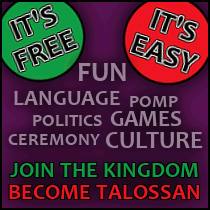Welcome to ROTFLonline, the Home Page of the Royal Opera/Talossan Football League, a partnership of two of Talossa’s largest and most respected cultural organizations.
The ROTFL Mission
The ancient sport of Berber football (futbol Taloçait) is the origin of both the art of opera and the sport we know today as Talossan football (futbol Talossan)…and thus of all games known as “football” around the world (not to mention chess). ROTFL is dedicated to preserving and promoting the historical connection between opera and football in Talossa, and furthering understanding of the Berber roots of both pastimes. We achieve this goal through public education, facilitating cooperation between local opera companies and football clubs, and sponsoring joint performances of the two. We believe that, to the greatest extent possible, football games and opera performances should be enjoyed in conjunction, in traditional Berber fashion.
The History of Opera and Football
In the earliest days of Berber football, opera and football were one and the same. One was rarely if ever performed without the other. In modern Talossa, of course, opera and football exist independently of each other, but vestiges of their ancient connection survive to the present day.
At some point the athletic and musical aspects of Berber football separated. The musical component survives as opera, which was almost lost until it was rediscovered in late 16th century Italy by a group of Florentine intellectuals who sought a revival of Greek and Berber theatre. This group, known as the “Camerata,” believed that parts in Greek and Berber theatre were primarily sung rather than spoken. They may have been mistaken about the ancient Greeks, but when it came to the Berbers they were spot on.
Greek drama itself, of course, was heavily influenced by Berber culture – especially after the West was increasingly exposed to Berber culture through the rise of Carthage as a major trading power during the 6th and 5th centuries B.C. This “Berber period” of Greek drama coincides with the development of the tragedy and the comedy and the Greek Enlightenment.
The athletic component of Berber football diversified into the many forms of football found around the world today, including American and Canadian football (or gridiron football), association football (soccer), Rugby football, Australian rules football, and Gaelic football. But of all the varieties played today, the most authentic descendant of the original Berber sport is Talossan football.
The Separation of the Operathletic Arts
The origins of the practice (considered aberrant, even sacrilegious, by purists) of separating football and opera are unclear. It likely started with occasions when inclement weather forced Berber football events to be held indoors, where the musical portion of the program would be performed without athletic accompaniment. (The board game chess had a similar origin as an attempt to enjoy football when bad weather or lack of players precluded playing outdoors. There is some record of ancient chess matches being played while spectators rapidly jiggled the board; precursors of the early electric vibrating gridiron football simulation games for young children of the 1960’s and 1970’s.)
Over time, for better or worse, many opera enthusiasts came to prefer the superior acoustics of the indoor opera house. But opera performed alone still bears faint memories of its original role as a “halftime show” in Berber football. It is not for nothing that German sopranos frequently resemble defensive linemen. Operas even developed “halftime shows” of their own, in the form of the entr’acteor intermezzo.
The elimination of music from football was not so easily accomplished. The most obvious remnant of opera is the solo, in the form of the perfomance of the national anthem at modern sporting events. But other elements of opera are evident to the knowledgeable observer. The gridiron football halftime show fills the same role that opera did in a Berber football match, and its most traditional features are derived from Berber opera. Cheerleaders, for example, perform a degraded form of choral recitative combined with dance. Marching bands developed from an attempt to more fully integrate the orchestra into the opera performance.
Touchdown celebrations are another vestigial remnant of opera. Sometimes the relationship is fairly obvious. The University of Southern California’s mounted Trojan can easily be pictured as an opera character. Other sporting mascots like the University of Colorado’s buffalo Ralphie or the Denver Broncos’ stallion would be equally at home in a scene from a grand opera. Other times the relationship is more subtle. “Showboating” in the end zone after making a touchdown is a reflection of the football player’s instinctive urge to participate in a theatric performance, just as Berber football players often played roles on the stage every bit as important as their roles on the field. And gridiron football features extra points and conversions after touchdowns for much the same reason that Berber football invented the replay: Berber football fans would call for repeat performances of remarkable athletic feats just as they called for encores of remarkable musical performances.
And football is not the only sport to retain a Berber influence. In Berber football, some operas were so familiar to the spectators that the whole audience participated in the more popular choruses. This tradition survives in the singing of “Take Me Out to the Ball Game” during baseball’s seventh inning stretch.
With this history in mind, it becomes clear why football and theatre both feature “plays,” and why opera performers and football competitors are both called “players.” In the beginning, their fans saw no difference between them.





